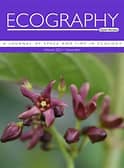“Site-occupancy modelling is widely used in ecology for understanding species distribution, habitat-use and community changes but its application is still limited in paleoecology, where incomplete detection is also routine. Here, we make extensive expansions to an earlier multispecies occupancy model used to estimate the dynamics of relative species abundance in fossil communities. These expansions include incorporating counts of individuals at sites, explicitly allowing for the inclusion of specimens assignable to genus – but not species-level, a situation common in paleontology, and modelling regional presence/absence. We provide simulations to check the performance of this new model, as well as simulations to quantify the benefits of using individual count data versus subsample occupancy data, and model estimates versus face-value (raw) estimates, respectively. We also provide an empirical case study using occupancy data from a community of marine benthic colonial animals preserved in the Pleistocene of New Zealand. We find that the new model performs well, especially when it comes to recovering relative abundance dynamics and that it is well worth the effort to both collect individual count data and to include individuals unidentified to species-level in the site-occupancy modelling framework. This extended model can be widely applied in paleoecological settings and is necessary when both the average and uncertainty values of relative abundance dynamics need to be robustly estimated.” Open Access!

